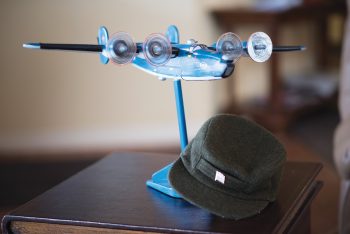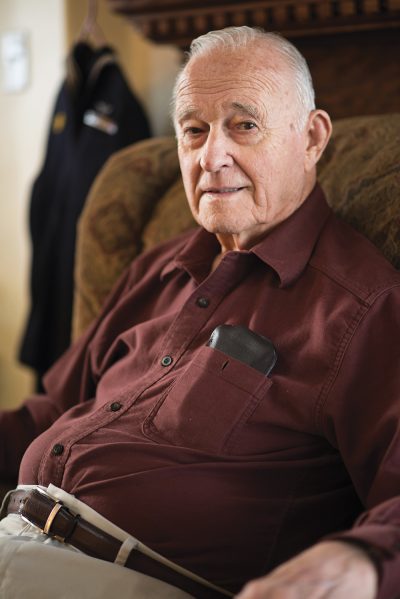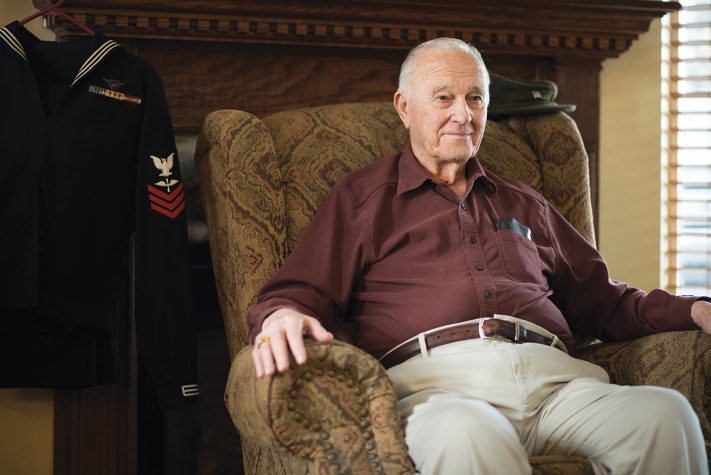Edward Anthony Maierle Retells his B-24 and B-17 survival maneuvers
Text by Polly Kolstad and Photography by Jesse Martinez
It has been a few years since Edward Anthony Maierle was employed at Fligelman’s Department Store in Helena, Montana.
He was working there December 7, 1941, the day Pearl Harbor was bombed. He immediately enlisted in the U.S. Navy and flew to Hawaii to become an “Avenger” (American torpedo bomber World War II) stationed on Pearl Harbor.
 “Many of the men stationed at the Receiving Station in Honolulu were actually killed,” says Maierle.
“Many of the men stationed at the Receiving Station in Honolulu were actually killed,” says Maierle.
“Those that survived fled and were hiding in the hills above Pearl Harbor.”
He was one of them.
His lively conversation belies the fact that he is 95 1/2 years old as he details how he swam through the oil infested water to rescue a B-24 sea plane off Hawaii’s shore. “I was all greased up and had to take a rope with a hook on it to pull a seaplane up with a tractor.”
His story brightens as he points to a photo bulletin board displaying pictures of him next to a B-24 and a B-17.
One of five waste hatch gunners on the PBY, a World War II seaplane, he manned the “machine,” positioning himself behind a 50 caliber machine gun. These were the Navy bombers at the time.
At the time, if you had an out, the only way to get back to the U.S. was on a PT boat (a Patrol Torpedo armed attack craft used by the U.S. Navy in WWII which was fast and secure with two machine guns on each side.)
His off shore Navy duty time was spent on Esperitu Santo New Heberde Island (today, the new republic of Vanuatu) where he was in the B-24 Squadron and lived in quonset huts for two years. Their mission was to patrol the air everyday against the “Zeros,” the Japanese fighter planes that had big red zeros on sides of plane.
“Every Monday night one of the Zeros, ‘Wash Machine Charlie’ flew by.”
“We went into the mangrove trees to hide.”
 Later, Ed was stationed for one year on Whidbey Island, Washington where he and his wife, Mary Alice, were married.
Later, Ed was stationed for one year on Whidbey Island, Washington where he and his wife, Mary Alice, were married.
When he came back to Helena, he worked for the Post Office for one year. It just happened that his father- in-law who worked there, got him the job. “I’ve always had a good job and made money.”
For two summers, he worked as a fire watch on a lookout in Coeur d’Alene National Forest. He and Mary Alice lived thirty feet up in the tower. They were the first U.S. couple to do so. Prior to their position, the department hired only single men, but discovered they didn’t value and keep the job.
“It was the best experience I had,” he says referring to the excitement of working thirty feet up in a tower in one big room with a bed and a cook stove. They always had a snow bank at the foot of the tower to keep things cold. He maintained mountain trails when not on the lookout and encountered the only other residents of the area: bears, deer and elk.
Mostly, on the lookout, Ed didn’t get many vacations and Mary Alice missed the excitement of traveling. She had a friend whose husband worked for Metropolitan Life Insurance and earned a trip to San Francisco every year. She liked the thought of a California vacation, and convinced him to become an agent. He did and over the 18 years he worked for Met Life, he made the Honor Club and earned the annual trip.
He eventually became assistant manager and sold insurance.
Standing tall, his eyes light up when he talks about his cabin at York, Montana, fifteen miles from Helena where Trout Creek meandered by and wild turkeys lingered. He lived there for twenty years. “You ought to have seen my wood pile,” he says, shirt sleeves still rippling through muscle rolls.
He has lived through many presidential terms beginning with Roosevelt, yet, the “brilliant, humble John F. Kennedy” was the best. Today, his favorite possible candidate would be, Ben Carson. Some of the others were “shiny-off,” he recalls.
Altering perspectives, he has always had good health and enjoyed ballroom dancing. The last time he danced, his partner said, “slow down, you’re gonna have a heart attack.” Ed has lived in Great Falls for the last year and a half to be close to his daughter, Jan Stoick. Son, Mick Maierle, of Bozeman visits often and he sees daughter, Vicki Foss, when she flies up from California.
Ed’s gratitude runs deep for a good long life. One thing that stands out is a bronze plaque honoring him and Mary Alice for twenty-four years of service to the Helena area nursing homes.
Those special and memorable moments came right after church every Sunday.
“That’s where we went,” he says.

